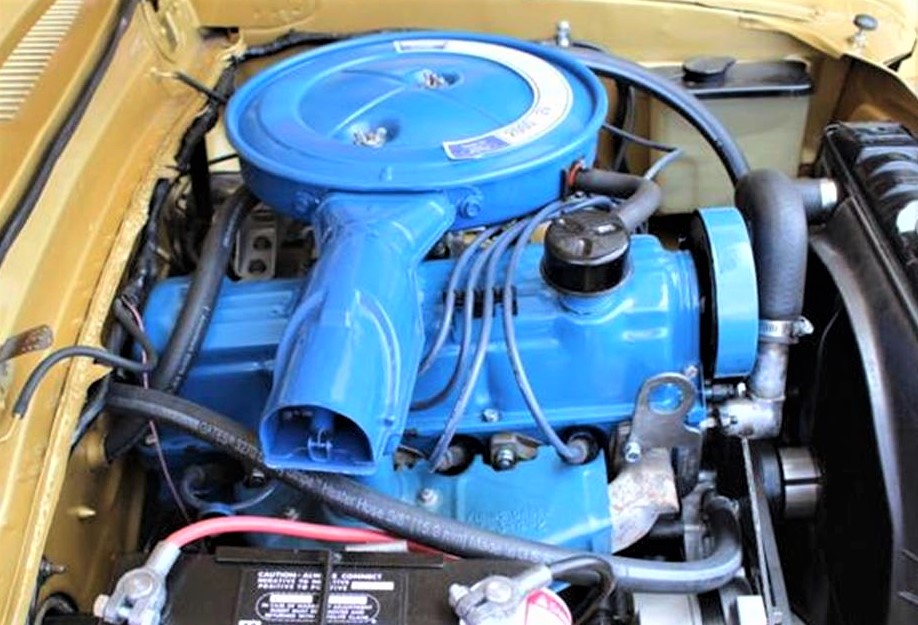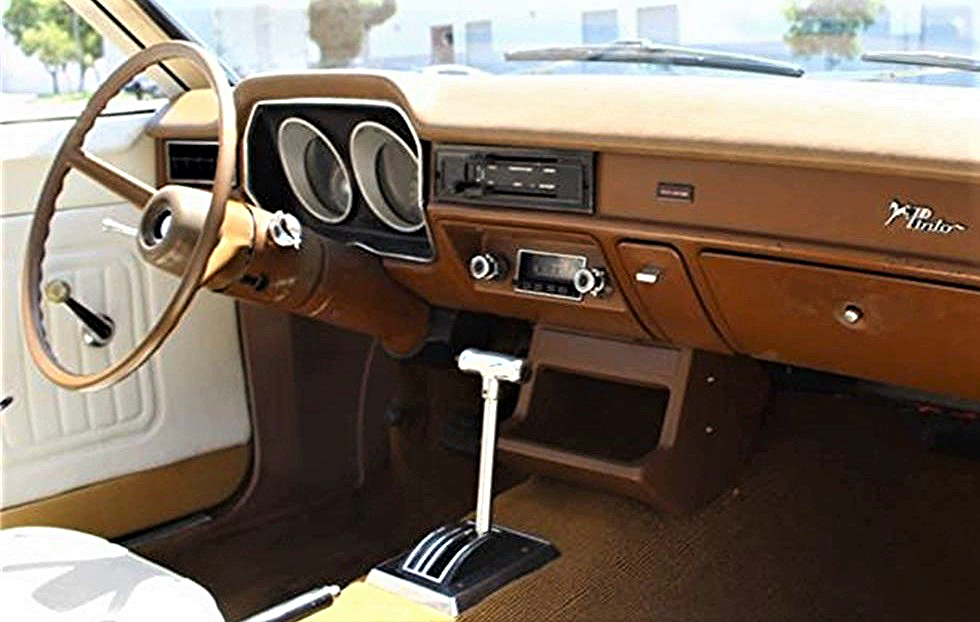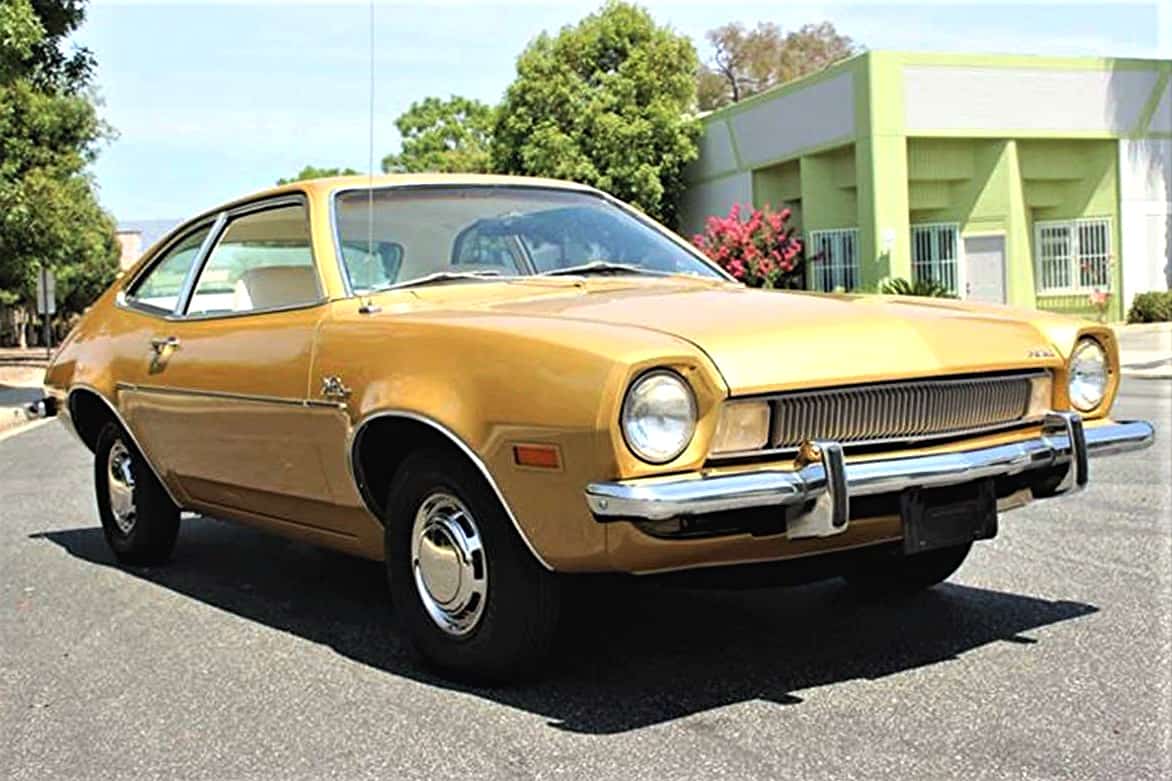The Pinto was not a bad little car for its time, Ford’s first attempt to produce an inexpensive subcompact in the U.S. to battle the onslaught of thrifty little vehicles from overseas. It was introduced in 1970 just one day after introduction of GM’s import fighter, the Chevrolet Vega.
Unlike Vega, which had myriad reliability issues, Pinto benefitted from tried-and-true mechanical components from Ford’s European cars, and they were actually fun to drive.

But there was a problem: In a rear-impact collision, the gas tank filler neck could pull loose, spewing gasoline all over the place and… well, you know the rest of the story.
And so, Ford Pinto became a punchline. The little car also became symbolic of the hubris of the auto industry, which seemed to put public safety on the backburner, so to speak.
It was later determined that Pinto’s propensity for bursting into flames was overstated, and essentially no worse than many other cars of that era. And retrofit kits remedied the problem. But the die was cast, public perception was irreparably tainted and used Pintos became pretty-much worthless.

Which is why the Pick of the Day, a “professionally restored” 1973 Ford Pinto sedan, is such an unusual find. Because really, who goes about having a Pinto restored, by pro craftspeople, no less? But here it is.
“What we have here is a professionally restored 1973 Ford Pinto 2-door sedan in immaculate condition, with believed-to-be 64,200 original miles,” the La Verne, California, dealer says in the car’s advertisement on ClassicCars.com. “All glass, trims and rubber are in excellent condition. The chrome bumpers gleam, this car looks brand new!”

The Pinto, powered by a 2.0-liter 4-cylinder engine with an automatic transmission, does indeed look showroom fresh in stock condition with a nice paint job and refurbished interior.
“The exterior, engine compartment and trunk have all been re-finished in what appears to be a factory Gold Glow paint color or very similar,” the seller says. “The interior is laid out in white vinyl with bucket seats up front and bench in the rear. The interior carpet complements the Gold Glow exterior color.”
This Pinto would be a fun anti-snob vehicle for cruising around and displaying at car shows. It could even be a welcomed entry at the Concours d’Lemons.

The asking price of $15,900 might be a tad high, but as they say, try and find another one in this condition. The pro restoration likely cost more.
To view this listing on ClassicCars.com, see Pick of the Day.






too much free time…
Remove the Gas Tank & You Have a Good Car ! !
Kind of like the side tanks on chevy trucks?
Or, the driver killing airbags on most late model imports?
So…… Title says 1970, picture says 1972, and write-up says 1973. Is this a Johnny Cash “mash-up” Car ?
Your headline says its a ’70, ……the caption says it’s a ’72,…..and the article says it’s a ’73.
Do you guys proof anything?
Terrible.
I owned a 1975 Pinto Pony MPG Sedan with the indestructible 2.3 liter German Ford engine. I built the engine up to 220 horsepower, using an Offenhauser 4 barrel intake manifold, Iskdarian camshaft, 11 to one pistons and Clifford headers. It came stock with a C4 Ford automatic transmission that got a big cooler, and a shift kit. I could take so-called sports cars of the days with ease, and haul a three rail dirt bike trailer at 80 mph to the desert. Drivers in 924 Porsche’s would pound on the steering wheel as a stock looking pinto blew their doors off. It was a strong reliable compact car that was fun to drive with all that power. Along with a five main bearing engine, and a crankshaft that weighed 75 pounds.
70, 72 or 73?
It was the hatchback model that had the fuel tank punctured by too long a screw(u bolt?) issue
Typos happen
I read that court documents suggest few other cars were as efficient at killing passengers. Some surmise that the Pinto had a three-pronged attack:
1) Engine would inexplicably stall, causing car to come to unexpected stop on the roadway.
2) Subsequent rear collision by other unsuspecting vehicle would rupture the Pinto’s fragile gastank, spewing fuel and engulfing cars in fire.
3) Pinto’s doors were easily jammed in rear collision due to poorly designed body structure, thereby trapping innocent occupants and ensuring a painful death by fire.
Sounds horrific.
Whoever said "they were actually fun to drive?" My girlfriend received a brand new one for her 16th birthday back in 73 and it was absolutely the worse car I have driven until my next girlfriend who owned an AMC Pacer. Nice hottie girls, bad cars!
What’s with the engine color. That’s not ford blue! Not a very professional restoration
This is the kind of restoration that begs to ask the age old question, "WHY ???"
The Pinto was a good car for its time with excellent fuel economy and good reliability, especially compared to some of its rivals. Most of all, it was the right car for its time. The fuel tank issue was so blown out of proportion by Mother Jones and other media outlets it was ridiculous. They made it seem as if Ford were intentionally TRYING to kill people with the car! Granted, Ford’s PR dept. could have handled it better once the story did break. Once the recall was issued and a design change was made starting in 1974, the problem was solved. However, as the author states, the damage was done to the reputations of both the car and Ford; and this proved to be the Pinto’s undoing. Ford continued to improve it through the 70’s but those improvements did nothing to boost sales. Although the sales could not have been too bad; despite a major controversy the Pinto remained in production for over 10 years, relatively unchanged. A relative of mine owned one back in the late 1980’s, a used 1978 model, that proved to be a solid, reliable car that served her well with little to no complaint.
I had a 71 with 1.6 liter 4 speed and the trunk not the hatchback the color is the same mustard yellow . I was the second owner with 48k on it when purchased it still had bias ply tires on it back in 1992. I paid $550 for it not bad for a Rustfree pinto in Buffalo. Hung onto the pinto for a few years didn’t do anything to it but drive her in the summer months. Sold her in 95 for $3500 with the original window sticker price $1700 so I made out well had I know that I could have gotten a lot more ten years later I probably would have kept her longer
Why would someone do that to an early Pinto *with an automatic?!?* A slushbox in a small car from that era (or many years thereafter) is a giant sponge soaking up any fun that might be had driving it.
Shouldn’t most Pintos have had the recall bladder installed?
More importantly, I have 1971 that I drove until it broke down. It may not be a popular classic but I had people stop and talk to me and tell stories although time – good car if you like to talk.
Our family owned a 73 hatchback for a few years. My dad bought it new. It looked exactly like the pea soup green one in Sorcerer’s Apprentice. It was poor quality. The automatic transmission had to be replaced twice the first year. After that we had problems with the speedometer which had to be fixed a couple of times. There was horrendous squeaking from doors vibrating against the car body at freeway speeds. Within the first couple of years every knob and handle in the car’s interior had come off and both hatch struts had failed. The rear hatch wiper never really worked very well at all. And that’s just what I remember off the top of my head. It seemed like there was always something that we were trying to fix or taking in for service.